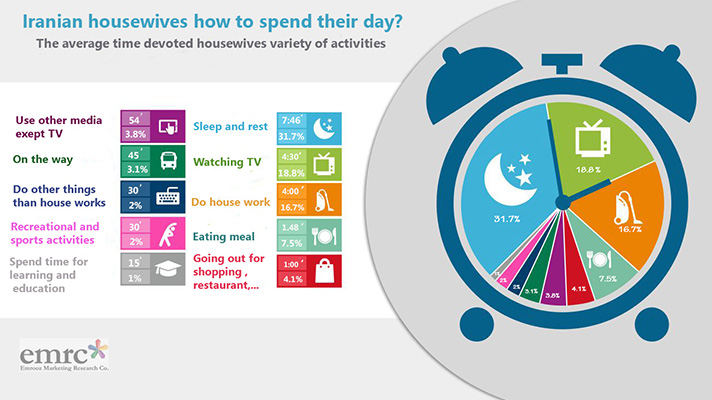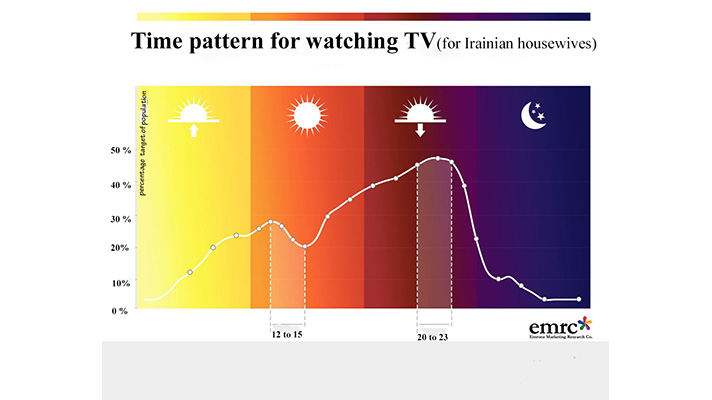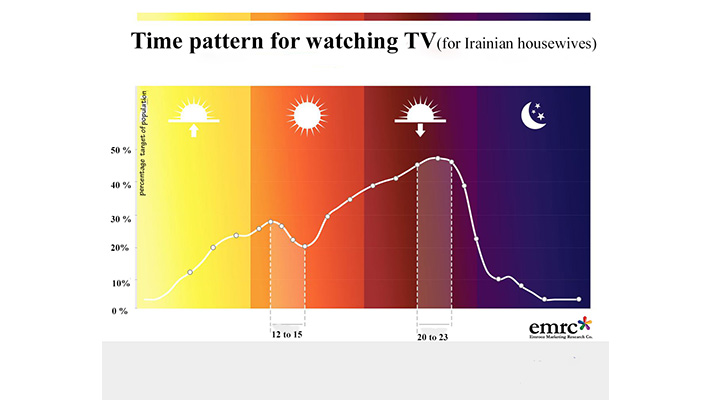
The Magic Box That’s Ruling Our Lives
Iranian housewives spend more than 4 hours a day watching television.
What’s the first thing that pops into your head when you hear the word “Housewife”? When you hear this word you subconsciously think of a woman who spends most of her time at home. You know that they run the house, do the cooking and take care of the children and assume that they pursue hobbies such as embroidery or sewing and spend the rest of their spare time socializing with family and friends.
If you’re asked what a housewife spends most of her time doing you will probably confidently say “Housework “(What else can you say given the nature of the work “Housewife”?!)
However, according to new statistical findings, we have to replace our outdated perception of housewives and replace it with a more modern and realistic one. In recent years, Iranian women’s lifestyles has gone through significant changes.
A Day in The House by The Numbers
We at Emrooz Marketing Research Co. have reached an interesting conclusion in our recent statistical inquiry.
According to our findings, after sleeping which takes up an average of 7.6 hours per day of the typical Iranian housewife’s time, they spend 4.5 hours watching television; making it their most time consuming daily activity.
Eating and drinking takes an average of 1.8 hours of their time. Exercising and other non-housework related activities each take up to 30 minutes. The amount of time they spend on other media is as little as 0.9 hours and studying or learning new skills only takes 0.25 hours of their time.
Housewives also spend an hour a day outdoors shopping or socializing and their average commuting time is 45 minutes.
There are quite a lot of interesting facts in these statistics such as:
· Watching television is a housewife’s main activity in her waking hours.
· The amount of time a housewife dedicates to watching television is 5 times more than the time she spends on other forms of media such as web browsing, reading, listening to the radio, etc.
· They spend an extra 30 minutes watching television compared to the time they dedicate to housework.
· They only spend 15 minutes per day studying and learning new skills.
However, another part of our research here at Emrooz Marketing Research Co. focused on creating a timeline of housewives’ television viewing habits. As you can see in the chart below, from the earliest hours of the day television viewership gradually increases. As we reach mid-day (12PM-3PM) however viewership drops for a brief period as a result of time being spent on cooking, eating and doing housework.
In the evening, TV viewership keeps a steadily ascending rate which peaks during 8PM-11PM. As we reach midnight and sleeping hours the ratings drop until the next morning.
These Profitable Waves
Recent theories in the media field suggest that today’s world is the world of “Geomedia”. Meaning that media doesn’t only inspire changes on a regional scale. On the contrary, it can have a global inspiration and that is what makes it more of a focus point than before for the key players.
If we study this data from a national and cultural viewpoint, we can see that television has an undeniable influence on society’s cultural livelihood.
Which other media outlet that you know of has an audience of this size who pay 4.5 hours of undivided attention to it? And what happens if we level the playing field for foreign companies and corporations that can provide specifically tailored content for the audience’s cultural and psychological preferences? If we consider the fact that a large number of housewives are stay-at-home moms who play an undeniably important role in shaping our future generations, we can see that changing their lifestyle greatly affects the future generations.
Questions like these and providing analytically accurate answers to them helps pave the way for using television as a foundation on which we can build our society’s future on.
Now let’s take a look at this data from a business point of view; Imagine a business whose target audience are housewives. These numbers prove that in order to succeed in marketing and selling the product, one cannot miss the golden opportunity that television provides.
Even though booking commercials in popular television channels can prove to be costly for the marketing campaign, by creating high quality and engaging content coupled with smart distribution, the product will be made well known to the target audience.
In the next article we will continue this research and focus on another growing part of the Iranian society which are working women. We’re looking forward to sharing our findings with you
Source: EMRC










